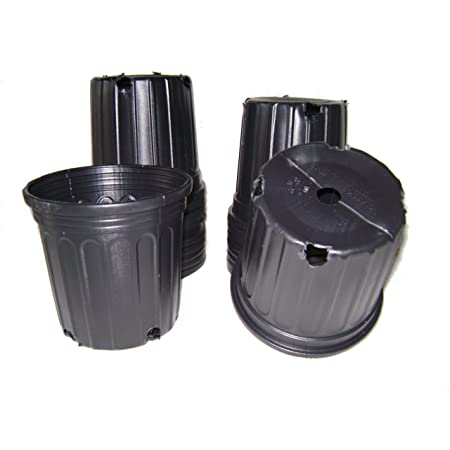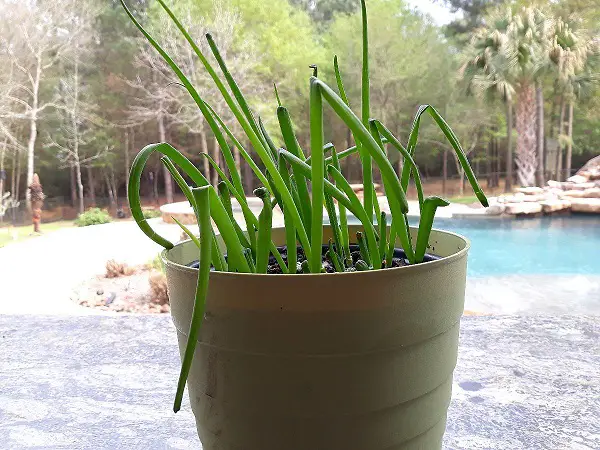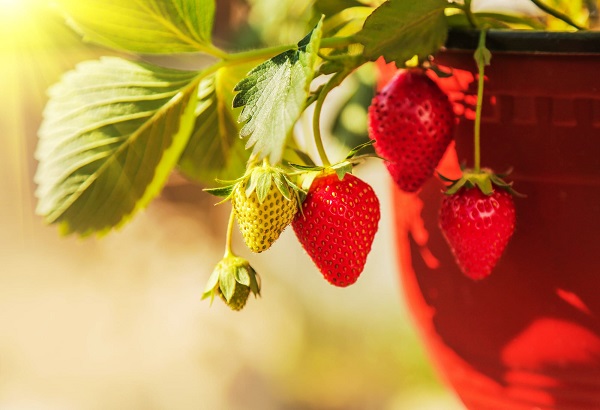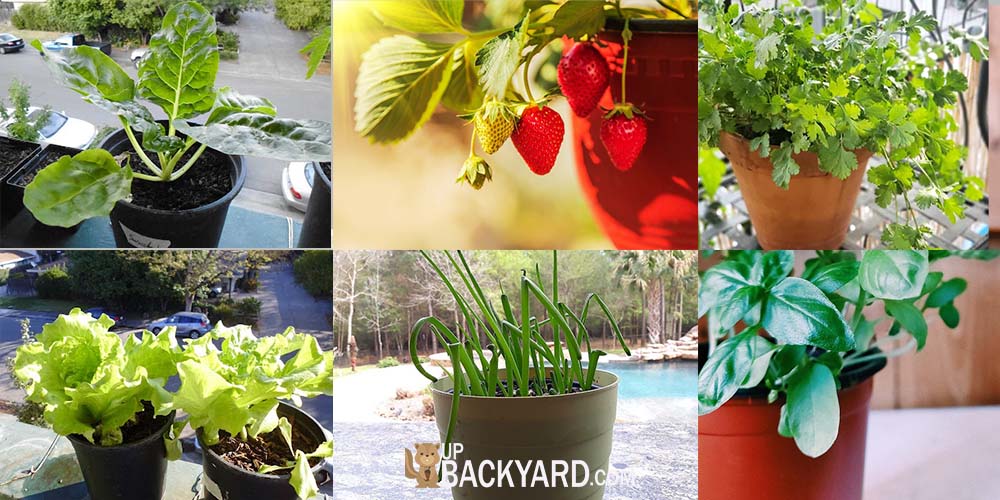If you have ever wanted a garden but are limited in space, you are in luck. Growing crops in containers is simple, easy, and very successful.
Container gardens are increasing in popularity thanks to a resurgence in wanting to grow our food.
Before, people who lived in apartments may have been left out due to a lack of their own garden space, but thanks to container gardens, they too can enjoy homegrown vegetables and herbs.
So, what can I grow in a one-gallon container?
While it may not seem like much, a one-gallon size container is large enough to grow many vegetables and even some fruit.
Basil, carrots, green onions, lettuce, spinach, strawberry, parsley, and cilantro can all thrive in container gardens!
Read on to learn more about container gardens, what you can grow in them, and the benefits of starting your container garden today!
What Size Is a 1 Gallon Container?

Now that you know the benefits of growing a container garden let’s look at how large a 1-gallon container is.
A 1-gallon container is approximately 7 inches in height and width.
You can gather your 1-gallon containers at a local garden center or nursery.
They are the smallest garden containers suitable for growing seedlings and mature plants. Besides, many herbs and even some vegetables grow very well in them.
What Can I Grow in a One Gallon Container?
When it comes down to it, 1-gallon containers are not as large as we would think.
Many vegetables like tomatoes, eggplants, peppers, onions, pole beans, and cucumbers do well in container gardens but need much more space. So what can you grow in a one-gallon container?
Even with the limited space, you can still grow an impressive and diverse container garden with only one gallon-sized pot. Basil, carrots, green onions, lettuce, spinach, strawberry, parsley, and cilantro all can thrive in your small container garden.
Basil

Nothing brightens a dish like a handful of fresh basil. Whether you want to use it in sauces or for a delicious Caprese salad, being able to pick it up from your balcony or patio instead of running to the store is priceless.
Basil continues to grow new leaves throughout its lifespan, meaning you can have a continuous supply.
If you run out of recipes to use your fresh basil in, you can dry it and save it to use later.
Lettuce
Eating your leafy greens has never been easier or more convenient. If you grow lettuce in your container garden, you will have access to fresh, crispy leaves whenever you need them.
Lettuce makes a perfect container plant because it requires little space. You will be able to grow one head of lettuce in a 1-gallon pot, so if you are a salad lover, you may want to grow more than one plant.
Otherwise, you can harvest a few leaves at a time and allow the plant to continue to grow.
You might also like: When Is The Best Time To Plant Lettuce in Texas?
Green Onions

Green onions make a delicious addition to everything from stir fries to baked potatoes. Thanks to their small size, you can grow many of them in a 1-gallon pot.
When it is time to harvest the green onions, uproot the whole plant. Think of how you purchase them at the store.
You have the long green stem and the white bulb with the roots still attached. Once they have been removed, you can plant new seeds.
If you plan on using them frequently, it is best to grow them in batches.
Carrots
Carrots are a bit more tricky when it comes to growing in containers. While they can be grown in 1-gallon pots, going for a deeper pot allows you to produce a longer carrot.
In a 1-gallon pot, you can grow 2-3 carrots simultaneously.
Carrots grow underground, meaning that instead of growing upward and into the infinite space of air, they travel downward, where they meet the bottom of the pot. This will stunt their growth severely or even cause them to grow sideways.
Strawberry

While strawberries are fruits, they make excellent container plants. Many gardeners are growing their strawberries in hanging baskets.
Since the strawberries are small, a 1-gallon container still produces a large yield of strawberries!
Strawberry plants can live for about five years before they begin to slow down their production. That is a lot of strawberries!
Cilantro
Cilantro is a fantastic kitchen herb to grow in 1-gallon containers. It is a versatile herb called for in many different types of cuisines and helps add that finishing touch to many recipes.
Cilantro seeds can be placed close together in the pot. These herbs will grow in dense populations.
Be sure to keep harvesting the cilantro periodically to help encourage new growth; they will grow back quickly!
Spinach
Like lettuce, spinach is a great plant to grow in your container garden.
However, if you had to choose between spinach or lettuce, it might be better to go with spinach as it grows much faster than lettuce. It is also a smaller plant, producing more in a smaller space.
Spinach will continue to grow even after you harvest it, giving you a continual supply of fresh greens. It also grows well in cooler weather.
Parsley
Like basil, parsley is an excellent addition to many recipes. The tiny curled herb adds brightness and depth to soups, plates of pasta, and casseroles. It is also incredibly versatile, being used in many sauces and dips.
Growing parsley is easy, especially in a 1-gallon pot. Like most herbs, the root systems are small. You can even grow them in the same container as basil or cilantro to save on counter space!
Tips for Container Gardens
Be sure to read up on the types of crops you are hoping to grow in your garden. Each plant has different needs regarding sunlight, water, soil, and humidity.
You will also need to know and understand how to harvest each crop. Some crops will continue to grow back on their own, while others will need to be replanted once they are harvested.
Choose a healthy and fresh bag of all-purpose garden soil as the base for your pots. You will also want to ensure that each container has adequate drainage holes.
Without these, water will pool at the bottom of the pot and can lead to root rot, killing your plants. If the pot does not have enough, you can add a few more yourself.
When using decorative pots, they usually do not have adequate drainage holes. Therefore, it is a good idea to plant inside a plastic garden pot and place the garden pot inside the decorative pot for aesthetics.
This can also be beneficial because garden pots are light, while many decorative pots are made of heavier and often breakable materials.
Benefits to Growing a Container Garden
When it comes to growing our vegetables and herbs, not everyone is blessed with bountiful land and the appropriate amount of sunlight or rain.
Container gardens offer an option for everyone to partake in gardening fun.
Small Spaces
One of the main advantages of growing crops in containers is that they do not take up much space.
You can easily have a small container garden on patios, balconies, or kitchen window sills.
Container gardens are ideal for those who live in apartments or in homes that do not have an adequate backyard.
No Digging
Perhaps the best part of having a container garden is not having to dig up your yard to plant crops.
Growing a container garden may be right for you if you want all the benefits of delicious vegetables and herbs without all the hassle.
Instead of having to dig, you can plant seeds in pots and watch your food begin to grow!
The other perk to not having a traditional garden is not having to pull weeds that are coming up through your garden!
Quality Control
When choosing a container garden, you get to control many aspects that you usually would not be able to.
For example, the soil you use, the amount of light the plant receives, and the watering schedule can all be modified and kept in a controlled environment when growing in containers.
Since you can move the plants around quickly, they can follow the sun or even be brought inside under a grow light.
You also can control the humidity levels with humidifiers. Some plants thrive in humid conditions. Using a portable greenhouse or plant cover can also help your plants thrive.
Final Thoughts
Container gardens are making their way into the lives of many urban gardeners.
When it seems like a garden would be out of the question due to the lack of space or even the absence of a yard, container gardens swoop in and save the day.
Since they are small, easy to manage, and can be grown just about anywhere, there is no denying their allure.
You can grow just about anything in containers. Some plants require larger containers. For example, many tomatoes and peppers would prefer a 5-gallon pot. However, many plants can be grown in a 1-gallon container.
Basil, carrots, green onions, lettuce, spinach, strawberry, parsley, and cilantro are all crops that can happily thrive in these smaller containers.
In addition, herbs like basil, parsley, and cilantro can be grown together in one pot, saving even more space and creating your own living herb supply.
There is no denying the benefits of a container garden. Being able to grow them in apartments or smaller homes, not having to dig up the yard or pull weeds, and being able to control the quality of the soil, water, humidity, and light the garden receives are all huge pros for a container garden.
